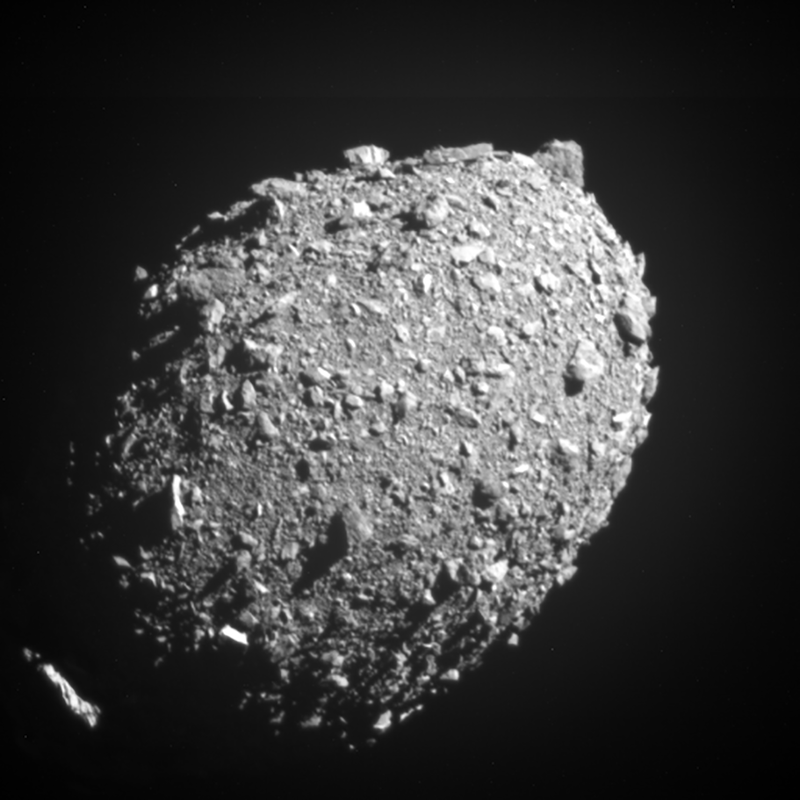Watch the DART asteroid impact video here.
Remember when NASA sent a spacecraft crashing into an asteroid … on purpose? It was on September 26, 2022 – a stunning moment – as the 1,200-pound NASA spacecraft called DART struck a tiny moon of a small asteroid, with the goal of minutely changing its orbit. The larger asteroid is Didymos, and the moon is Didymos B, aka Dimorphos. Many earthly telescopes were trained on the asteroid impact. And NASA’s Hubble Space Telescope captured a great series of images. On March 1, 2023, NASA scientists released a new timelapse movie, based on the Hubble images. The movie shows the moment of impact! And it shows debris streaming outward from the asteroid in complex patterns.
DART stands for Double Asteroid Redirection Test. And it was a test, the first dedicated test ever, of our human ability to change the course of an asteroid.
The DART impactor hit the asteroid at a whopping 13,000 miles per hour (20,900 km/hr). Overall, the DART asteroid impact blasted over 1,000 tons of rock and dust into space.
Along with the movie, a group of 63 DART researchers, led by Jian-Yang Li of the Planetary Science Institute in Tucson, Arizona, published a new peer-reviewed paper in Nature on March 1.
Last chance to get a moon phase calendar! Only a few left. On sale now.
DART asteroid impact in real time
Didymos B aka Dimorphos orbits its larger companion asteroid, Didymos. And neither asteroid is headed toward Earth. But what if one of them were headed toward us? The impact altered the orbit of the little moon by a tiny amount. It’s the idea that – with some practice – we could learn to deflect an asteroid, preventing a collision with Earth.
Watching the impact in real time was a thrill! And now we have the Hubble movie, which reveals details and records hourly changes in how the debris dispersed. As Li explained:
The DART impact happened in a binary asteroid system. We’ve never witnessed an object collide with an asteroid in a binary asteroid system before in real time, and it’s really surprising.
I think it’s fantastic. Too much stuff is going on here. It’s going to take some time to figure out.

The movie shows 3 stages of the impact
Overall, there were three stages to the impact’s aftermath as the rocky debris was flung away from the asteroid.
Stage 1. The movie starts 1.3 hours before the impact itself. The two asteroids are so close together, as seen from Earth, that Hubble can’t see each one individually. To Hubble, they looked like one bright dot. Hubble took its first post-impact image two hours after the impact. And you can see debris flying away from the asteroid, moving faster than four miles per hour (six kilometers per hour). To begin with, the debris forms the ejecta cone, which is largely hollow, with long stringy filaments coming off it.
Stage 2. begins 17 hours after impact. As the debris interacts with the gravity of both asteroids, it changes from the shape of the ejecta cone to that of a swirling spiral … like a giant pinwheel. This spiral is gravitationally tied to the larger asteroid Didymos, which surprised astronomers, as Li noted:
This is really unique for this particular incident. When I first saw these images, I couldn’t believe these features. I thought maybe the image was smeared or something.
Stage 3, a comet-like tail
Stage 3. Next, the astronomers note the effect of sunlight pushing the debris behind Dimorphos. The pressure of sunlight creates a long, comet-like tail for the debris. The lightest particles of the debris move the fastest and are now farthest from the asteroid.
Later, astronomers are puzzled when the tail splits into two parts for a few days. Li commented:
We have observed a number of active asteroids that displayed tails. Some hypotheses have been postulated for what caused the formation of the tails, one hypothesis being due to impact. The DART impact and the subsequent tail formation definitively demonstrates that an asteroid tail can origin from an impact, and provides the details of the ejecta evolution and the tail formation that will form the direct observational basis for the interpretations of past and future observations of active asteroids.

Summary of the impact’s aftermath
Li summarized the aftermath of the impact this way:
A simple way to visualize the evolution of the ejecta is to imagine a cone-shaped ejecta curtain coming out from Dimorphos, which is orbiting Didymos. After about a day, the base of the cone is slowly distorted by the gravity of Didymos first, forming a curved or twisted funnel in two to three days.
In the meantime, the pressure from sunlight constantly pushes the dust in the ejecta towards the opposite direction of the sun, and slowly modifies and finally destroys the cone shape.
This effect becomes apparent after about three days. Because small particles are pushed faster than large particles, the ejecta was stretched towards the anti-solar direction, forming streaks in the ejecta.
DART asteroid impact: Mission success!
DART – the Double Asteroid Redirection Test – was the first such test by NASA to try to alter the path of an asteroid. NASA did this to learn how to potentially divert an asteroid should one ever be on a collision course with Earth. And it worked. Last October, NASA confirmed that the DART impact succeeded in altering Dimorphos’ orbit by 32 minutes, from 11 hours and 55 minutes to 11 hours and 23 minutes.
That might not sound like a lot, but it was more than scientists had expected.
Bottom line: NASA has released a new Hubble movie of the DART asteroid impact from September 26, 2022. The sequence of images shows the impact and resulting spray of debris.
Source: Ejecta from the DART-produced active asteroid Dimorphos











